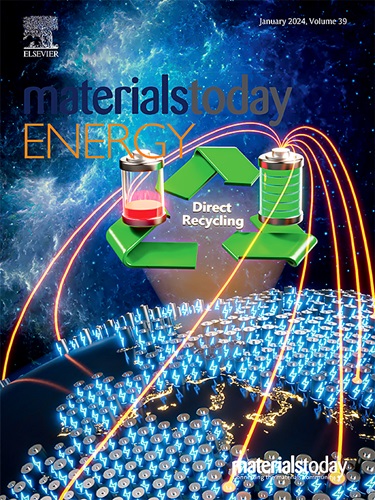Waste-derived carbon quantum dots for improving the photostability of perovskite solar cells to > 1,000 h
IF 8.6
2区 材料科学
Q1 CHEMISTRY, PHYSICAL
引用次数: 0
Abstract
Power conversion efficiency (PCE) of perovskite solar cells (PSCs) has reached 26.1%, but PSC devices are plagued by poor stability when exposed to light (especially ultraviolet (UV) radiation), heat, and moisture. UV stability remains a significant challenge to overcome. Luminescent down-shifting (LDS) filters have shown significant enhancement in photostability and efficiency for PSCs. However, most explored LDS materials are costly, non-biodegradable, and the resulting photostability is limited to ∼100 h. In this report, as-obtained waste filtrate from the polyaniline (PANI) synthesis is used to synthesize fluorescent PANI carbon quantum dots (PANI-CQDs) using a facile hydrothermal method. Here we report, for the first time, the use of waste-derived PANI-CQDs to fabricate UV filters that are low-cost, bio-degradable, and room-temperature processible and, importantly, impart high UV and photostability to the PSCs. PSCs with these filters retained 90% and 100% of their initial performance when exposed to UV light and AM 1.5 solar radiation, respectively, for more than 900 h, while PSCs without filters degraded to 14 and 70% of their initial performance under the same conditions. Hence, we clearly show that using a waste-derived LDS filter improves the UV stability of PSCs by six times and photostability beyond 1,000 h.废物衍生碳量子点可将过氧化物太阳能电池的光稳定性提高到 > 1,000 小时
过氧化物太阳能电池(PSC)的功率转换效率(PCE)已达到 26.1%,但 PSC 器件在暴露于光线(尤其是紫外线(UV)辐射)、热量和湿气时稳定性较差。紫外线稳定性仍然是一个需要克服的重大挑战。发光下移(LDS)滤光片已显示出 PSC 光稳定性和效率的显著提高。在本报告中,我们利用聚苯胺(PANI)合成过程中产生的废滤液,采用简便的水热法合成了荧光 PANI 碳量子点(PANI-CQDs)。在此,我们首次报道了利用从废弃物中提取的 PANI-CQDs 制备紫外线过滤器的方法,这种过滤器成本低、可生物降解、可在室温下加工,更重要的是,它能为 PSCs 带来高紫外线和光稳定性。当暴露在紫外线和 AM 1.5 太阳辐射下超过 900 小时时,带有这些滤光片的 PSC 分别保持了 90% 和 100% 的初始性能,而在相同条件下,不带滤光片的 PSC 退化到了 14% 和 70% 的初始性能。因此,我们清楚地表明,使用从废物中提取的 LDS 过滤器可将 PSC 的紫外线稳定性提高六倍,光稳定性超过 1,000 小时。
本文章由计算机程序翻译,如有差异,请以英文原文为准。
求助全文
约1分钟内获得全文
求助全文
来源期刊

Materials Today Energy
Materials Science-Materials Science (miscellaneous)
CiteScore
15.10
自引率
7.50%
发文量
291
审稿时长
15 days
期刊介绍:
Materials Today Energy is a multi-disciplinary, rapid-publication journal focused on all aspects of materials for energy.
Materials Today Energy provides a forum for the discussion of high quality research that is helping define the inclusive, growing field of energy materials.
Part of the Materials Today family, Materials Today Energy offers authors rigorous peer review, rapid decisions, and high visibility. The editors welcome comprehensive articles, short communications and reviews on both theoretical and experimental work in relation to energy harvesting, conversion, storage and distribution, on topics including but not limited to:
-Solar energy conversion
-Hydrogen generation
-Photocatalysis
-Thermoelectric materials and devices
-Materials for nuclear energy applications
-Materials for Energy Storage
-Environment protection
-Sustainable and green materials
 求助内容:
求助内容: 应助结果提醒方式:
应助结果提醒方式:


